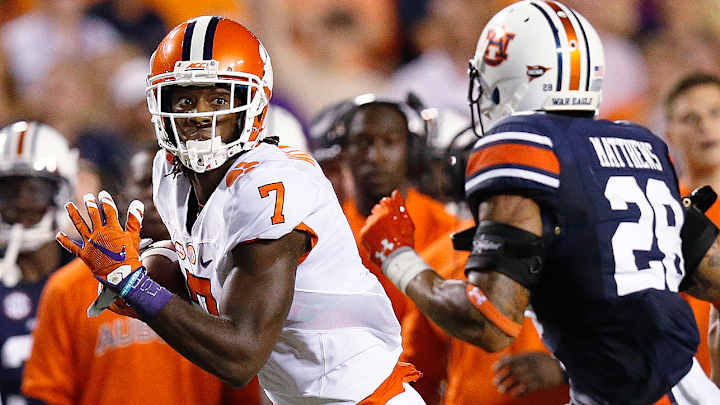2017 NFL draft prospect countdown, No. 18: Mike Williams, WR, Clemson

What you need to know: Williams may have arrived in the NFL a year ago were it not for the freak injury he suffered in Clemson’s 2015 season opener. While making a touchdown catch against Wofford, Williams was shoved into the goalpost and fractured his neck, which knocked him out for the remainder of the year. He returned in 2016 to catch 98 passes for 1,361 yards and 11 touchdowns as Clemson won the national title, all good enough to land him a first-team All-ACC spot. Williams also topped the 1,000-yard mark as a sophomore, and he wrapped his college career with 2,727 yards receiving. He had nine 100-yard games as a Tiger, topped by his 202-yard performance against Pittsburgh in November. Two weeks later, Williams set a single-game best with three touchdown catches against South Carolina.
Mike Williams's scary neck injury only delayed his inevitable destination: Round 1
Strengths: Williams ran a 40-yard dash in the 4.5-second range at Clemson’s Pro Day (reported times ranged from 4.49 to 4.58). He is 6' 4" and 218 pounds. Put that size and speed together, and it’s no surprise that Williams can be a quarterback’s best friend downfield. Deshaun Watson let fly on the deep ball time and again with Williams, who averaged 15.4 yards per catch during his Clemson career.
“I’m a big, physical receiver,” Williams said. “I can go get the deep ball, I’m going to block on the edge. I just do it all in one.”
The slant route is the other NFL-ready weapon in Williams’s game. He uses the threat of those over-the-top looks to set up defenders, then snaps his routes inside. His size makes it difficult for any DB to then get back through him to defend the ball, and Williams shows good burst to slice through the defense after the catch on those slants.
Williams’s excellent body control saved Watson quite a few incompletions during their time together at Clemson. Williams can contort back toward the ball while running at full speed, plus he seems to have that important, innate sense for where the boundary is. In other words, he can make a tough catch and get his feet down.
He improved as his Clemson career progressed at winning on contested catches, as well. His size provides him a natural advantage there, but he also displayed more aggression in high-pointing the football above defensive backs’ heads. Count on seeing that talent in the red zone next year.
Weaknesses: One reason he has had to be so good tiptoeing the sideline is that he will, at times, allow defenders to block him off in that direction. How effective he can get off the line against NFL press coverage could be a slight concern, because Williams does not always play to his size advantage.
He’s also not as polished a route runner as others in this receiving class, like Western Michigan’s Corey Davis. The slant is the best display of Williams’s footwork, and he obviously has those deep-release routes in his repertoire, but will he be able to come open in other ways at the next level? If not, he’ll be limited to a big-play option, as opposed to a high-volume receiver.
While his neck injury did not hold him back at all last season, it is a factor for NFL teams to consider when picking through his medical reports.
NFL player comparison: Alshon Jeffery
